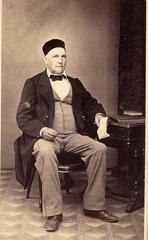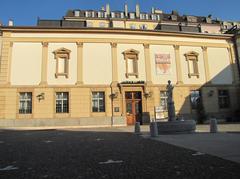Neuchâtel Castle: Visiting Hours, Tickets, and Historical Highlights
Date: 03/07/2025
Introduction
Perched high above the city and Lake Neuchâtel, the Castle of Neuchâtel (Château de Neuchâtel) stands as an enduring symbol of Swiss heritage and architectural grandeur. With origins in the early 11th century, this castle has served as a fortress, noble residence, and seat of regional governance, reflecting the region’s dynamic political and cultural history. Today, the castle welcomes visitors to explore its storied past, panoramic vistas, and vibrant cultural offerings. This guide details visiting hours, ticketing, accessibility, guided tours, and travel tips to help you plan an enriching visit. For official visitor details, see the LatLon-Europe history overview, the official Neuchâtel tourism resources, and MySwitzerland’s Castle of Neuchâtel page.
Table of Contents
- Introduction
- Historical Overview
- Architectural Evolution
- Visiting Information
- Highlights and Attractions
- Practical Travel Tips
- Frequently Asked Questions (FAQ)
- Visuals and Media Suggestions
- Conclusion & Call to Action
- References
Historical Overview
Medieval Foundations
The Castle of Neuchâtel’s earliest mention dates to 1011, when Rudolf III of Burgundy gifted the “novum castellum” to his wife Irmengarde (LatLon-Europe). Originally a fortified seat, its commanding position served both defensive and administrative functions, laying the groundwork for the city’s development.
From Feudal Seat to Prussian Principality
Following Burgundy’s absorption into the Holy Roman Empire, the castle came under the influential House of Neuchâtel, and later the Orléans-Longueville family. By the 18th century, Neuchâtel entered a unique personal union with the Kingdom of Prussia, reflecting a blend of Swiss autonomy and European royal ties (LatLon-Europe). The castle was central to these shifts, serving as the seat of government and symbol of authority through centuries of transformation.
Modern Era and Preservation
After the 1848 revolution, Neuchâtel became a republican canton within Switzerland, and the castle transitioned to administrative use. Ongoing restoration projects have preserved its medieval and Renaissance features, ensuring public access and cultural vitality (accidentallywesanderson.com).
Architectural Evolution
The castle complex displays a striking blend of Romanesque, Gothic, and Renaissance elements:
- Romanesque Origins: The south wing, constructed in the late 12th century, is Switzerland’s oldest civil building in continuous use (ne.ch).
- Gothic & Renaissance Additions: Adjacent to the castle, the Collegiate Church (1185–1276) showcases the region’s architectural transition, while 15th-century turrets and towers enclose two main courtyards (j3l.ch).
- Restoration: The 1980s restoration returned the castle to its historic appearance, with white façades and ochre-yellow frames (accidentallywesanderson.com).
Visiting Information
Opening Hours
- April to September: Guided tours daily, 10:00 AM to 6:00 PM.
- October to March: Limited access; tours by appointment only.
- Prison Tower: Open daily 6 AM – 6 PM (April – September).
- Castle grounds/exterior: Open year-round.
Always check the official website for updates and possible changes due to events or public holidays.
Tickets and Admission
- General Admission (Guided Tour): CHF 10
- Reduced (Students, Seniors): CHF 7
- Children under 12: Free
- Prison Tower: 1 CHF via turnstile
- Castle Grounds: Free (exterior areas only)
- Family & group rates: Available
Tickets can be bought online or on-site.
Guided Tours
- Tours last approximately 45–60 minutes.
- Languages: French (standard), English and German (on request/depending on season).
- Advance booking is recommended, especially for English and group tours.
Accessibility
- The castle offers partial accessibility; ramps are present in some areas, but historic architecture limits full wheelchair access.
- Please contact the administration for specific accommodations.
Visitor Amenities
- Restrooms: Available within the castle complex, capacity may be limited during peak periods.
- Dining: No café in the castle; numerous restaurants and cafés in the adjacent old town.
- Parking: Limited near the castle; public parking is available in the city center, followed by a short walk uphill.
Highlights and Attractions
- Collegiate Church of Neuchâtel: Romanesque-Gothic masterpiece adjacent to the castle.
- Prison Tower: Offers panoramic views and exhibits on Neuchâtel’s development.
- Old Town of Neuchâtel: Explore medieval streets, the Market Square, and Place des Halles.
- Lake Neuchâtel Promenade: Scenic lakeside walks and boat cruises.
- Maison du Prussien & Vauseyon Gorge: Industrial heritage and natural beauty.
Practical Travel Tips
- Best Time to Visit: June–September for full tour schedule and pleasant weather. Weekday mornings are least crowded.
- Getting There: 10–15 minutes’ walk from Neuchâtel train station; bus no. 1 to “Beauregard” stop.
- What to Bring: Sturdy shoes for cobblestones, weather-appropriate attire, camera, water, and some cash (CHF).
- Language: French is primary; English and German widely understood in tourist contexts.
Frequently Asked Questions (FAQ)
Q: What are Neuchâtel Castle’s visiting hours?
A: Guided tours run daily 10 AM–6 PM (April–September); limited tours October–March. Prison Tower open 6 AM–6 PM (April–September).
Q: How much do tickets cost?
A: Guided tours: CHF 10 (adults), CHF 7 (reduced), children under 12 free.
Q: Is the castle accessible for people with disabilities?
A: Partial accessibility; some areas are not wheelchair accessible. Contact the administration for details.
Q: Are guided tours offered in English?
A: Yes, but less frequently; booking ahead is advised.
Q: Are pets allowed?
A: Only service animals are permitted inside.
Q: Can I take photos?
A: Yes, in most areas. Flash and tripods may be restricted indoors.
Visuals and Media Suggestions
- Include high-quality images of the castle exterior, Prison Tower, Knights’ Hall, and panoramic vistas of Lake Neuchâtel.
Alt tags: “Neuchâtel Castle visiting hours,” “Neuchâtel Castle panoramic view,” “Neuchâtel historical sites.” - Embed an interactive map detailing the castle’s location and surrounding attractions.
- Link to a virtual tour or video if available.
Conclusion & Call to Action
Neuchâtel Castle is a living monument that weaves together the region’s medieval origins, political intrigue, and architectural splendor. Whether you’re drawn by history, stunning views, or cultural events, the castle offers a rewarding and memorable experience. For the latest visiting hours, events, and guided tour availability, consult the official Neuchâtel tourism website, or explore more insights at LatLon-Europe and MySwitzerland.com.
Plan your visit today, download the Audiala app for curated audio guides, and follow us on social media for updates and exclusive tips!
References
- LatLon-Europe, 2025, History of Neuchâtel Castle
- MySwitzerland.com, 2025, Neuchâtel Castle Experience
- Neuchâtel Tourism Office, 2025, Official Visitor Information
- Accidentally Wes Anderson, 2025, Château de Neuchâtel Architectural Highlights
- J3L.ch, 2025, Guided Tours and Cultural Heritage
- Swiss-Spectator.ch, 2025, Neuchâtel’s Identity and Heritage

